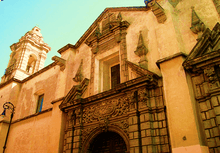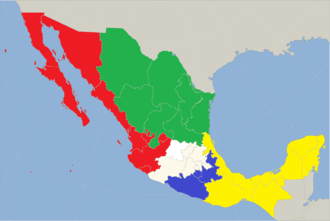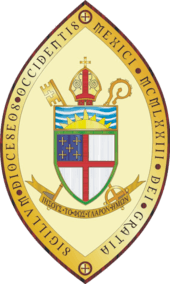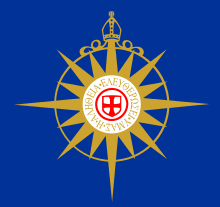Anglican Church of Mexico
| Anglican Church of Mexico | |
|---|---|
| Primate | Francisco Moreno |
| Territory | Mexico |
| Members | 100,000[1] |
| Website | Anglican Church of Mexico Official Website |
The Anglican Church of Mexico (Spanish: La Iglesia Anglicana de México), originally known as Church of Jesus, is the Anglican province in Mexico, and includes five dioceses. The primate is Francisco Moreno, Bishop of Northern Mexico.[2] The shield of the denomination uses the colors representing Mexico as well as those of the Episcopal Church (US) recognizing its historical connection with the US church.[3]
History

The Anglican Church of Mexico can trace its roots to the Mexican War for independence in 1810, but it was the Reform War that led to the foundation of the Church. Religious reforms in 1857 secured freedom of religion, separating the Roman Catholic Church from government and politics. In 1860, the newly formed Church of Jesus contacted the Protestant Episcopal Church in the United States of America, seeking leadership, guidance, and support. In 1879, the first bishop, Henry C. Riley, was consecrated. In 1958, the fourth missionary bishop of Mexico was the first of the Church's bishops to be consecrated on Mexican soil. The Church became an autonomous Province of the Anglican Communion on 1 January 1995.
Membership
Today, there are 52 Anglican parishes in Mexico, 36 missions, and 12 other affiliated institutions.[4]
Structure

The polity of the Anglican Church of Mexico is episcopal, as is true of all other Anglican churches. The church maintains a system of geographical parishes organized into dioceses. There are 5 of these, each headed by a bishop.[3] Each diocese is divided into archdeaconries, each headed by a senior priest. The archdeaconries are further subdivided into parishes, headed by a parish priest. Several of the dioceses are named in Spanish merely for a compass direction — del Occindente, del Norte, del Sureste — which translate directly as "of the West" &c.[5] However, the Episcopal Church and other English-language Anglican Communion sources instead render these names with "Mexico" — e.g. "of Western Mexico" — so these are the forms used on the English-language Wikipedia.
Diocese of Mexico
In 1879, diocesan bishop Henry C. Riley was ordained and consecrated by the Episcopal Church in the United States of America as "Bishop of the Valley of Mexico", to exercise oversight over the Mexican "Church of Jesus". Riley resigned in 1884 and the care of the independent church lapsed to the Presiding Bishop of the Episcopal Church. Henry Forrester, the church's local administrator, was elected Bishop of the Valley of Mexico, but died before consecration.
In 1904, the Episcopal Church formed all of the Mexican Republic into one Missionary District of Mexico, for North American Anglicans/Episcopalians in Mexico;[6] and which the native Church of Jesus joined in 1906.[7][8] That year, Henry D. Aves was consecrated first Missionary Bishop of Mexico and resigned in 1923. In 1926, Frank W. Creighton succeeded him as second missionary bishop.[9] In 1972, the Episcopal Church divided the missionary district in three, creating those of Northern and of Western Mexico, and renaming the remaining portion as Central & Southern Mexico; on 1 January 1980, all three were erected into dioceses. In 1988/9 the Central and Southern diocese was again split in three, creating the Cuernavaca and Southeastern dioceses, the remainder being named, again, the Diocese of Mexico (City).[10] The diocese today is based in Mexico City, where it's Cathedral is St Joseph of Grace.
- Missionary bishops of the Missionary Diocese of Mexico
- 1879–1884: I diocesan bishop Henry C. Riley, Bishop of the Valley of Mexico[10]
- the Presiding Bishop, Provisional Bishop
- Henry Forrester, bishop-elect
- 1904–1923: II diocesan bishop Henry D. Aves (first missionary bishop)
- 1926–1933: III diocesan bishop Frank W. Creighton, Bishop of Michigan
- 29 September 1931 – 1934: suffragan bishop Efrain Salinas y Velasco, suffragan bishop[8]
- 1934–1957: IV diocesan bishop Efrain Salinas[11]
- 1958–1972: V diocesan bishop José G. Saucedo (fourth missionary bishop; continued as Diocesan Bishop of the new Diocese of Central & Southern Mexico)
- 1964–1972: suffragan bishop Leonardo Romero, suffragan bishop[6] (became I diocesan bishop of the new Diocese of Northern Mexico)
- 1964–1972: suffragan bishop Melchor Saucedo, suffragan bishop[6] (became I diocesan bishop the new Diocese of Western Mexico)
- 1912–1980: V diocesan bishop José Saucedo (last missionary bishop continued as diocesan bishop of the now renamed Diocese of Central & Southern Mexico )[12]
- Bishops of the Diocese of Central & Southern Mexico (former Missionary Diocese of Mexico)
- 1973–1989: V diocesan bishop José G. Saucedo (became first Diocesan Bishop of the new Diocese of Cuernavaca)
- 22 March 1980 – 1982 (resigned): suffragan bishop Roberto Martinez-Resendiz suffragan (in Nopala, Hidalgo)[13][14]
- 22 March 1980 – 1989: suffragan bishop Claro Huerta Ramos, suffragan (in Arroyo Zacate, Veracruz;[15][14] became I Diocesan Bishop of the new Diocese of Southeastern Mexico)
- 1985 – 1997: suffragan bishop Martiniano García Montiel, suffragan
- Bishops of the Diocese of Mexico (former Diocese of Central & Southern Mexico)
- 1989 – 2003: VI diocesan bishop Sergio Carranza Gomez[16]
* 1990 – 2018 (died): Auxiliary Bishop Roberto Martinez-Resendiz
- 2002 – 2020: VII diocesan bishop Carlos Touché Porter[17]
Diocese of Northern Mexico
Created in 1972 from the missionary district of Mexico; erected a diocese in 1980. Based in Monterrey, Nuevo León; where is the Cathedral of the Holy Family.
- Bishops of Northern Mexico
- 1972 – 1986 (d.): I diocesan bishop Leonardo Romero[18] (also Bishop-in-Charge of El Savador from 1984)[19]
- 1987 – 2002 (deposed for embezzlement and fraud [20] ): II diocesan bishop German Martínez Márquez
- 2003 – 2010: III diocesan bishop Marcelino Rivera Delgado
- 2010 – 2020: IV diocesan bishop Francisco Moreno
Diocese of Western Mexico

Created in 1972 from the missionary district of Mexico; erected a diocese in 1980. Based in Zapopan, Jalisco; cathedral of St Paul in that city.
- Bishops of Western Mexico
- 1972 – 1981: I diocesan bishop Melchor Saucedo Mendoza
- 1981 – 2002 (deposed for embezzlement and fraud [21] ): II diocesan bishop Samuel Espinoza V.
- 2003 – 2018: III diocesan bishop Lino Rodríguez Amaro[22]
- 2018 – 2030: IV diocesan bishop Ricardo Gómez Osnaya
Diocese of Cuernavaca
Erected from the Central & Southern diocese in 1988/9; Cathedral of St Michael & All Saints, Cuernavaca, Morelos.
- Bishops of Cuernavaca
- 1989 – 1997: I Diocesan Bishop José G. Saucedo
- 1997 – 2002: II Diocesan Bishop Martiniano García Montiel
- 2003 – 2010 (resigned on charges of sexual harrasment): III Diocesan Bishop Ramiro Delgado Vega
- 2010 – 2013: James Ottley (Interim)[23]
- 2013 – 2030: IV Diocesan Bishop Enrique Treviño Cruz
Diocese of Southeastern Mexico
Erected from the Central & Southern diocese in 1988/9; based in Xalapa, Veracruz.
- Bishops of Southeastern Mexico
Primates
- Primates of the Anglican Church of Mexico
- 1995 – 1997: José Saucedo (Cuernavaca)
- 1997: Claro Huerta (Southeastern)
- 1999 – 2002: (deposed for embezzlement and fraud [24] ): Samuel Espinoza (Western)
- 2002 – 2004: Martiniano Garcia Montiel (Cuernavaca; Acting Primate)
- 2004 – 2014: Carlos Touché Porter (Mexico)
- 2014 – 2020: Francisco Moreno (Northern)[25]
Worship and liturgy
The Anglican Church of Mexico embraces three orders of ministry: deacon, priest, and bishop. A local variant of the Book of Common Prayer is used.[26]
Social issues
The Anglican Church of Mexico allows women to be ordained as deacons and priests.[27] Additionally, some bishops of the Anglican Church of Mexico have expressed openness and support for women bishops and even homosexual clergy.[28] In 2007, Archbishop Carlos Touché-Porter became a co-patron of Inclusive Church advocating for '"a liberal, open church which is inclusive of all,' regardless of race, gender or sexuality".[29] He also advocated for the ordination of gay clergy.[30] Archbishop Touché-Porter's diocese, the Diocese of Mexico, "permits clergy in same-sex relationships to serve in the ministry."[31][32] In 2008, Bishop Sergio Carranza supported the ordination of LGBT clergy.[33] However, Francisco Moreno — the Primate — has opposed same-sex unions as the official stance of his church.[34] Nevertheless, St. Mark's Anglican Church in Guadalajara, Jalisco is one of the churches publicly affirming and supportive of LGBTQ rights.[35] At least one congregation has already supported blessing same-gender couples.[36]
In 2016, the General Synod of the church published a pronouncement declaring itself to be against all forms of violence and discrimination against migrants, victims of violence, or the LGBTI community.[37] Discussing the proposal to legalize same-gender marriages legislatively, a clergyman representing the Anglican church shared that "sexual diversity is a natural gift" and that he celebrates equal rights.[38] A priest responsible for communication encouraged the Congress to pass civil same-sex marriage.[39]
Doctrine and practice
The center of the Anglican Church of Mexico's teaching is the life and resurrection of Jesus Christ. The basic teachings of the church, or catechism, includes:
- Jesus Christ is fully human and fully God. He died and was resurrected from the dead.
- Jesus provides the way of eternal life for those who believe.
- The Old and New Testaments of the Bible were written by people "under the inspiration of the Holy Spirit". The Apocrypha are additional books that are used in Christian worship, but not for the formation of doctrine.
- The two great and necessary sacraments are Holy Baptism and Holy Eucharist
- Other sacramental rites are confirmation, ordination, marriage, reconciliation of a penitent, and unction.
- Belief in heaven and hell as states of being, and Jesus's return in glory.
The threefold sources of authority in Anglicanism are scripture, tradition, and reason. These three sources uphold and critique each other in a dynamic way. This balance of scripture, tradition and reason is traced to the work of Richard Hooker, a sixteenth-century apologist. In Hooker's model, scripture is the primary means of arriving at doctrine and things stated plainly in scripture are accepted as true. Issues that are ambiguous are determined by tradition, which is checked by reason.[40]
Ecumenical relations
Unlike many other Anglican churches, the Anglican Church of Mexico is not a member of the ecumenical World Council of Churches.[41] The denomination maintains ecumenical dialogue with the Roman Catholic Church and Orthodox churches.[42]
The Anglican Church of Mexico considers itself to be a part of the Global Center seeking to reconcile the divide between conservative and liberal provinces in the Anglican Communion while respecting diversity of opinion and practice.[43]
References
- ↑ Ramírez, Mariana Viayra. "Anglicanos mexicanos rechazan unirse a la Iglesia católica". cronica.com.mx. La Crónica. Retrieved February 10, 2016.
- ↑ "Bienvenidos a la Iglesia Anglicana de México". mexico-anglican.org. Retrieved 2016-06-20.
- 1 2 "Bienvenidos a la Iglesia Anglicana de México". mexico-anglican.org. Archived from the original on 2016-10-08. Retrieved 2016-06-20.
- ↑ "Bienvenidos a la Iglesia Anglicana de México". mexico-anglican.org. Anglican Church of Mexico. Retrieved February 10, 2016.
- ↑ La Iglesia Anglicana de México — Nosotros (Accessed 20 May 2018)
- 1 2 3 Episcopal News Service archives — Romero, Saucedo Consecrated; March 6, 1964 (Accessed 20 May 2018)
- ↑ La Iglesia Anglicana de Mexico (IAM) — Historical Preface (Accessed 20 May 2018)
- 1 2 3 4 Anglican Diocese of Southeastern México — Historic Summary (Archived from the original on 29 August 2009 and accessed 20 May 2018)
- ↑ Anglican History — The Church in Mexico, by Frank Whittington Creighton (Accessed 19 May 2018)
- 1 2 An Episcopal Dictionary of the Church — Mexico, Diocese of (Accessed 20 May 2018)
- ↑ Episcopal News Service archives — Funeral Services Held for Efrain Salinas; December 30, 1968 (Accessed 20 May 2018)
- ↑ Episcopal News Service archives — Jose Saucedo, Retired Primate of the Anglican Church of Mexico, Dies in Hospital; September 3, 1998 (Accessed 20 May 2018)
- ↑ Episcopal News Service archives — Mexican Diocese Chooses First Suffragan; May 31, 1979 & Mexican Suffragan Bishop Resigns; April 27, 1982 (Accessed 20 May 2018)
- 1 2 Episcopal News Service archives — Two Mission Bishops Consecrated in Mexico; April 3, 1980 (Accessed 20 May 2018)
- ↑ Episcopal News Service archives — Mexican Diocese Elects Second Suffragan; October 11, 1979 (Accessed 20 May 2018)
- ↑ Episcopal News Service archives — Carranza-Gomez Elected In Mexico; April 27, 1989 & Sergio Carranza-Gomez Consecrated Sixth Bishop of Mexico; October 17, 1989; & Episcopal News — Summer 2010: From Mexico to L.A., Bishop Carranza rises to challenges (Accessed 20 May 2018)
- ↑ Ekklesia — Archbishop of Mexico becomes Patron of Inclusive Church (Accessed 20 May 2018)
- ↑ Episcopal News Service archives — Romero Dies Following Surgery; June 5, 1986 (Accessed 20 May 2018)
- ↑ Episcopal News Service archives — Romero Given El Salvador Oversight; March 15, 1984 (Accessed 20 May 2018)
- ↑ The Living Church, Vol. 225. 25 August 2002, p. 6 & 29 September 2002, p. 6 (Accessed 20 May 2018)
- ↑ The Living Church, Vol. 225. 25 August 2002, p. 6 & 29 September 2002, p. 6 (Accessed 20 May 2018)
- ↑ La Iglesia Anglicana de Mexico — Provincial Contacts, December 2008 (Accessed 20 May 2018)
- ↑ Vida Anglicana — Noticias Octubre 2010 (Accessed 20 May 2018)
- ↑ The Living Church, Vol. 225. 25 August 2002, p. 6 & 29 September 2002, p. 6 (Accessed 20 May 2018)
- ↑ Anglican Communion News Service — Francisco Moreno elected Primate of Mexico (Accessed 20 May 2018)
- ↑ "Bienvenidos a la Iglesia Anglicana de México". mexico-anglican.org. Retrieved 2016-06-20.
- ↑ "Preguntas Frecuentes". mexico-anglican.org. Anglican Church of Mexico. Retrieved February 10, 2016.
- ↑ Figueroa, Héctor. "Habrá obispo mexicana en unos años: Iglesia Anglicana". excelsior.com.mx. Excelsior. Retrieved February 10, 2016.
- ↑ "SCOTLAND: Primus becomes co-patron of Inclusive Church | Episcopal Church". www.episcopalchurch.org. Retrieved 2016-07-06.
- ↑ Qureshi, Yakub (2007-10-03). "Archbishop's gay plea". Retrieved 2016-07-06.
- ↑ "Mexico backs Anglican Covenant: The Church of England Newspaper, July 9, 2010 p 5". Conger. 2010-07-17. Retrieved 2016-12-19.
- ↑ Conger, George (August 7, 2010). "Mexico Backs Anglican Covenant". churchnewspaper.com. The Church of England Newspaper. Retrieved December 19, 2016.
- ↑ Carranza, Sergio (2008). "The Truly Orthodox Anglicans". An Inch At a Time: Reflections On The Journey. Retrieved July 6, 2016.
- ↑ "Anglicanos y mormones contra matrimonios gay". Vanguardia. Retrieved 2016-06-18.
- ↑ "List Churches by Country - GayChurch.org". GayChurch.org. Retrieved 2016-04-30.
- ↑ "Anglicanos abren las puertas a gays en SLP; bendición de parejas homosexuales, en análisis - Pulso Diario de San Luis". pulsoslp.com.mx. Retrieved 2016-06-17.
- ↑ "Pronunciamiento de VIII Sínodo General de la Iglesia Anglicana de México". mexicoanglicano.wordpress.com. Anglican Church of Mexico. June 18, 2016. Retrieved June 19, 2016.
- ↑ Excélsior TV (2016-06-27), Impacto cultural de la inclusión homosexual en México / Opiniones encontradas, retrieved 2016-06-28
- ↑ "Temen cálculo electoral contra unión gay". Retrieved 2016-10-26.
- ↑ Anglican Listening Archived 2008-07-05 at the Wayback Machine. Detail on how scripture, tradition, and reason work to "uphold and critique each other in a dynamic way".
- ↑ http://www.oikoumene.org/?id=3587 World Council of Churches
- ↑ "Bienvenidos a la Iglesia Anglicana de México". mexico-anglican.org. Retrieved 2016-06-20.
- ↑ "Latin America, Caribbean bishops uphold diversity of Anglicanism | Episcopal Church". www.episcopalchurch.org. Retrieved 2016-07-07.
Bishops
Further reading
- Anglicanism, Neill, Stephen. Harmondsworth, 1965.
